Happy Sunday Readers!
Tis’ the season for cozy sweaters, cable knits, and cashmere leisure sets galore, so I thought it would be fun to do a sweaters-focused newsletter.
Thank you to the readers in chat who submitted some Q&A topics they were interested in learning about! It’s a big topic so I’ve broken it out into a Top 10 of what I thought would be fun and helpful to share. And in the spirit of the holiday season, I’m making this free for all subscribers — I want to help you all become more informed so you can make better purchasing decisions and extend the life of the sweaters in your wardrobe!
Here’s what I’ll be covering in this mini Sweaters 101 in case you want to skip to the sections that most interest you!
1. Yarns (different types of quality and how to look at yarn composition)
2. Construction (what to look for)
3. Production (a BTS on the labor of love required to make a sweater)
4. Costs (how to make sense of sweater costs)
5. Sustainability (what to look for to support sustainability)
6. Shopping + secondhand (not all good sweaters are new!)
7. Fit (types of fit that may determine whether you like or love a sweater)
8. Styling (ideas to get you through the winter season)
9. Care (how to extend the life of your sweaters - yes, I’ll cover pilling!)
10. Storage (let’s protect your sweaters so you can wear them next season!)
This guide is based purely on my background and experience — ten years working as a designer/product developer/production lead for private label (in-house) brands. I worked across most categories but my specialty was in sweaters. I don’t have a traditional design background but I was fortunate enough to visit innovative factories and learn as much as I could from my sweater suppliers and knitters in China, India, and Peru.
The one thing I want people to know about sweaters is that it is wildly different than any other clothing category because it combines textile design and apparel design. It’s not just taking a fabric and making a pattern and sewing it into a garment. It’s highly technical and the skillset (on both the design and manufacturing side) are not as easily transferable, similar to how denim or performance wear are niche categories.
You are designing the yarn as you make the garment — it’s like a giant puzzle piece. A series of small decisions that you make as you design, develop, fit, and produce the garment. One little change (yarn size, stitch, fit etc) can turn the garment into something completely else, for better or worse. But I found that’s also the beauty of sweater design. When the last puzzle piece fits - it’s magic!
YARNS
The highest quality, longest lasting sweaters are made of 100% natural fibers (cotton, cashmere, wool, alpaca are the most common):
Reason being that these fibers mimic the materials natural function that helps protect animals through the elements - insulating, breathable, biodegradable, moisture wicking
Longer, finer fibers = higher quality and softer hand feel
Shorter, coarser fibers = lower quality and dryer hand feel → short fibers are what cause pilling. If you think about how fibers are knit together, a short fiber will naturally break more, especially when faced with friction against body movements and other articles of clothing.
Within animal-based natural fibers, the most common are:
Merino wool is the highest quality within wool products. It tends to be softer and naturally wicks away moisture.
The highest Cashmere quality comes from Mongolia and quality is based on grades: Grade A is the highest quality and provides the softest, finest yarn. Grade B and Grade C have a dryer hand feel as they use a coarser yarn.
Synthetics or Blends
I generally don’t buy synthetic sweaters made of acrylic, polyester or nylon. Acrylic is one of the softest yarns available but it’s also one of the cheapest yarns. Brands use it because it creates a “cashmere-like” feel at a very affordable price which is why it pills like crazy, felts, and doesn’t retain it’s shape. When you compare the surface of a soft synthetic vs a cashmere, the synthetic usually has a slippery hand feel. Always remember that the softest sweaters aren’t always the highest quality so read the label!
Polyester and nylon are more durable and help strengthen wear zones so they can help natural fibers from breaking down faster (ie: pilling) but they are bad for the environment and won’t be as breathable. I’m personally ok with viscose as it’s made of wood pulp, has a silk-like hand feel, good drape, and doesn’t pill much.
If buying a blend, I aim for 80-90% natural fiber. Blends are used to hit certain price points but they also are used to create distinct texture, shape, or structure to a sweater that can’t be achieved if you do 100% natural fiber so for me, it comes down to how much I love the yarn and design details. For example, if I love a specific sculpted shape or a novelty yarn/stitch, I understand I won’t be able to find it in with an extremely high percent of natural fiber.
If you aren’t able to purchase that high of content, try to aim for the majority of yarn within a garment being in a natural fiber.
So how do you choose the best high-quality natural fiber sweater?
Unfortunately, brands don’t really talk about sweater content. It’s fairly complicated but at the same time, consumers are savvy and want to know what their clothes are made of so I appreciate brands like Naadam and Soft Goat who provide education around their materials.
At most, brands will provide the yarn composition and may provide the gauge of the yarn (essentially the thickness of the yarn, which can impact the drape, elasticity and overall look and fit) but they don’t indicate other key factors that go into the overall quality that would help make more educated purchasing decisions (especially online) such as:
cashmere grades (quality of cashmere based on thickness of the fiber; the lower the number, the finer the yarn)
weight (yarn is priced by kilo so the heavier the weight, the more yarn used and the “beefier” the garment; unless a sweater is intended to be incredibly light and silky, it should have some heft)
yarn ends (The number of yarns twisted together. The higher the ends, or ply, the stronger and denser the yarn will be. This isn’t necessarily an indicator of yarn quality but a higher ply adds warmth and increases strength and durability).
If a brand happens to provide the gauge (GG), the lower number will be beefier and warmer (3GG and 5GG) while the higher number will be lighter and more drapey (14GG and 16GG). I don’t necessarily think one is better than the other — it just depends on what you are looking for, the type of yarn used, and the design/wear intent.
For example, 7GG and 12GG yarn are the most commonly used in natural fibers. Higher end designers typically will go up to 16GG which is super-fine and tightly-knit to produce an incredibly light and silky feel. They also will ply up a 7GG or 12GG yarn 3-4x which is why they look and feel so much more substantial (more on that when we get to the costing section!).
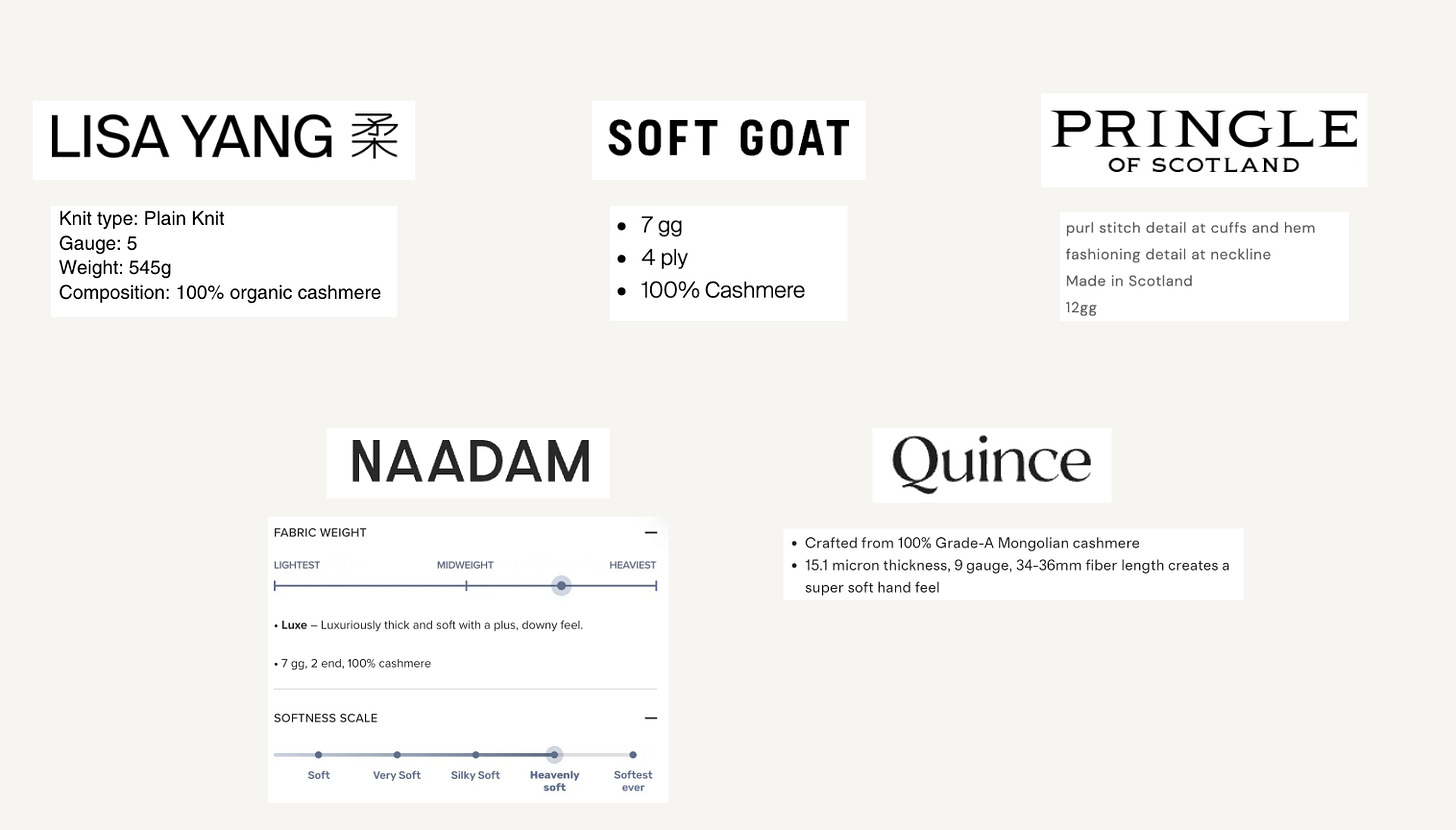
At a high level, this is my experience —
Cottons are durable and pill the least, even after regular machine wash, but always lay flat to dry!
Alpaca also doesn’t pill quickly as the fibers are quite long. The surface is also much more hairy than other natural fibers which I think helps “blend” in any light pilling. Alpaca can have quite loose tension so I like when a bit of poly or spandex are knit in.
Wool pills much faster and worse than Merino Wool. Wool can be quite dry and sometimes itchy so I prefer Merino or wools blended with ~5% silk to soften the hand feel and add a subtle lustre.
Cashmere really depends on the grade and how tightly knit it is. I try to avoid any cashmere that is overtly fluffy on the surface as it pills and wears faster. I prefer mid-heavyweight cashmere as it’s more durable vs anything too airy.
Here’s some tips when looking at fabrics while shopping:
Touch Test: Touch with the palm of your whole hand, not just your fingers. Use the back of your hand if you have sweaty palms! Don’t always assume the softest sweater is the highest quality. Brands will overwash or add silicone finishing to soften the initial product but this will wear off over time. Silicone finishing will have a slippery hand feel. Note darker colors may have a slightly dryer hand feel based on the dying process.
Rub Test: You can rub the yarn quickly between your hands to see if little pills start to already form (sign of yarn breakage).
Light Test: Hold the backside of the garment to the light. You want it to be more opaque than less and light should come through evenly, not spotty.
Stretch Test: Stretch a section of the garment - it should bounce back. If it stays stretched out, it may be a sign of lower quality or too loose of tension.
CONSTRUCTION
Some high level things I look out for when it comes to construction:
Tension is everything. Tension is how tight or loose a sweater is knitted. It can affect the fit, weight, hand feel, stretch and recovery and overall performance and longevity of a sweater. See the video below for how I test for this.
As a designer, if I wanted to make a sweater softer or more airy, I would loosen the tension. If I needed more structure and better recovery, I would increase the tension.
If the tension is too loose, it loses it’s elasticity which causes the sweater to stretch and grow over time and never recover it’s shape. The same goes for if a designer chooses too heavy of a yarn for something like a very chunky oversized sweater. Tension that’s too tight can cause a sweater to feel very stiff and boxy.
Stitches - The type of stitch used is based on the overall design intent so there aren’t really pros/cons between a jersey vs rib vs waffle stitch etc. A milano stitch is quite thick and structured which is nice for pieces like a sweater coat. Most fairisle and knit pattern sweaters are jacquard. You can also manipulate fabric surfaces, like brushed cashmere, which help create a softened effect.
From a quality perspective, I have found that ribs and cables pill a bit less as they need to be more tightly knit. For jerseys, try to look for one that’s not too loose and drapey.
Collars - I always prefer a doubled neck band as it looks more elevated and helps reduce stretching after wear.
Plackets - Look for straight, even edges and reinforced trims or elevated finishing on the ends.
Hem/Cuff - It depends on the design intent but I generally find a denser rib trim to look the cleanest over time.
Trims - For buttons, I avoid solid plastic buttons which can look cheap and opt for resin tortoise buttons which look more subtle against yarn. You can also look for self-covered yarn buttons, or metal. I also like pearl buttons but they are quite fragile and need replacing more often.
Video walkthrough of sweater collar examples
Video walkthrough of placket and cuff/hem construction and tension (for buttons, I also like to ensure they are reinforced close to the placket and not loosely stitched on)
PRODUCTION BTS
I wanted to share some BTS on sweater making because I think it’s fascinating (and maybe you will too!). I think it’s important as consumers to understand how our garments are made, and more importantly, know how many hands touch every scrap, thread, fabric, button, and garment you have in your closet regardless of the price point. Most of our clothes (if produced in an ethical factory) are made with so much love so it only makes sense to wear and care for our our clothes with love.
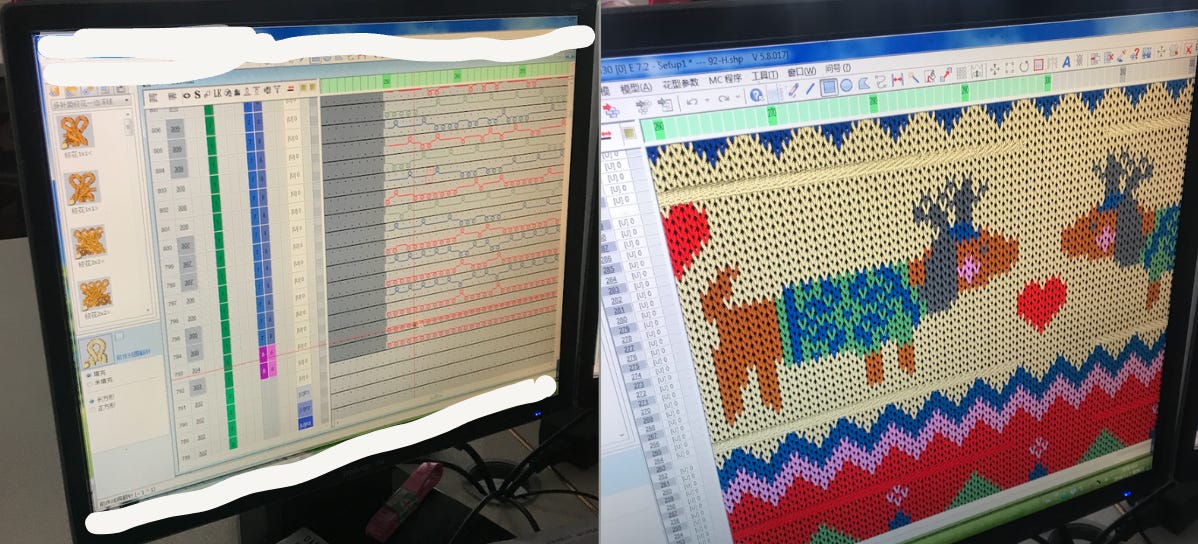
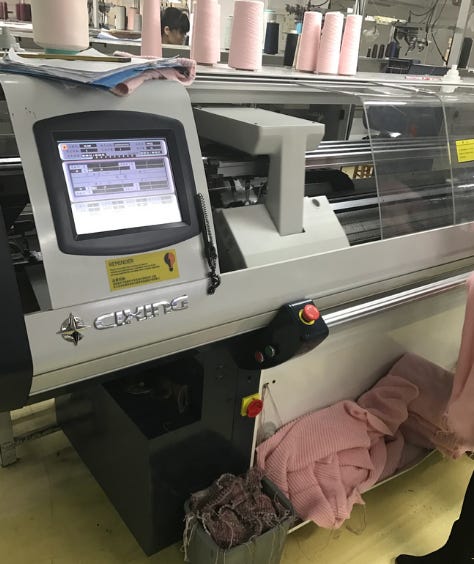
Machine knitting is the most commonly used as it’s efficient and consistent, lowering the overall cost. Every seam you see on a sweater is knit into panels by a machine (front/back panels, sleeve, cuff, hem, collar etc).
Factory workers inspect each panel and if there’s any snag or missed stitch, it goes through multiple quality control processes such as this one where a panel of fabric is being unraveled to then be re- knit again. (that’s me talking in the video as I was amazed when I first saw this process!)
Once panels are inspected, they are linked together row by row by a skilled operator through the process below, called linking. It’s my favorite process. It’s the highest skill level in a sweater factory - you need small delicate hands so it’s usually operated by women who have been learning for many years. This example shows a double collar being linked to a front panel. This video is just a short snippet I took but it’s quite a labor intensive process — if a stitch is missed, the operator has to unravel and re-link the section.
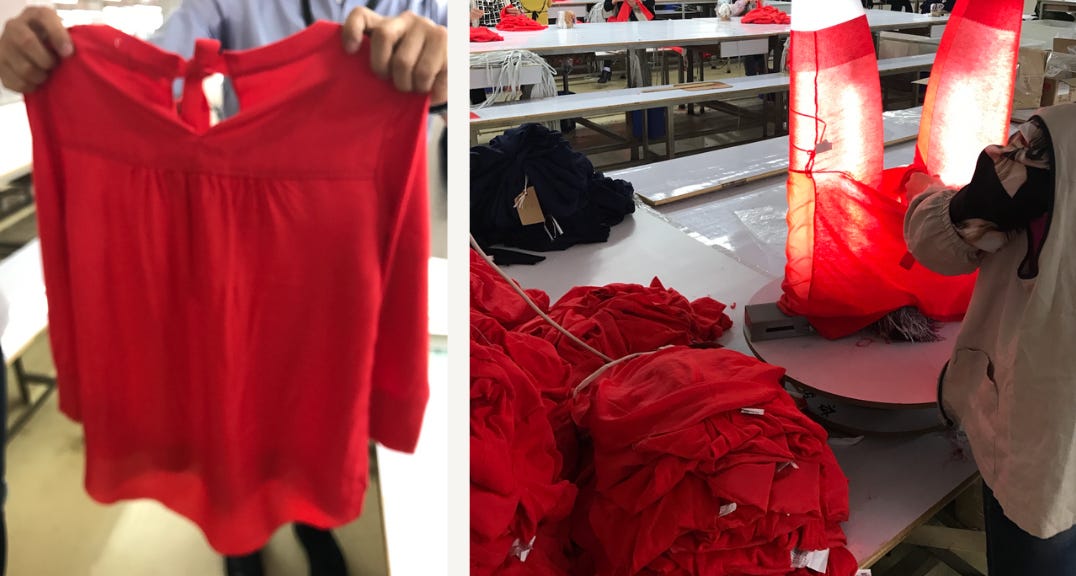
If you are interested in learning more about the process, this is a great video from Soft Goat that shows the cashmere process from goat to final product.
SUSTAINABILITY
This is a topic that is extremely complex as there’s so much gray area and sustainability can mean something different to everyone. I’m not an expert so I’ll just share a few points as it relates to the consumer side and my own experience.
For context, I helped in the development and execution of my previous company’s sustainability efforts and led the sustainable material strategy before I left my role and became a stylist. And what I will say is that trying to be sustainable is extremely hard and very grey from a brand/manufacturer side, especially if you don’t prioritize building it from the foundation like say, Patagonia.
I believe the greatest way to support sustainability as a consumer is to buy your clothes with the intent to wear for years to come. I always say it doesn’t matter if you spend $100 or $1000, treat them the same. When we keep our items for longer and then prioritize the resale channel to further extend the life, we aren’t contributing (as frequently) to the landfills. The best mentality I’ve adopted as both a producer and consumer of garments is “progress, not perfection”.
I think one of the most exciting updates in sustainability is regenerative fashion, where solution-focused impacts are being made from the beginning at the farm level and there’s a few great sweater brands focused on this innovative manufacturing process. (Micaela Greg, Vincent James, and Janessa Leone within her hats as well).
In a future world, I hope more brands start to design product intentionally with circularity in mind at every step - not just from the sourcing and manufacturing but once a garment actually gets to a consumer. Repairing, recycling, upcycling, and filtering that back into the supply chain to further extend the lifecycle.
Recycled Yarns
Pros: It extends the life of a material like polyester or wool or cashmere and in some cases depending on the manufacturing process, can reduce energy consumption and water usage.
Cons:
I have found recycled yarns to have a rougher hand feel and depending on the yarn supplier, there can be limited color choices as you are using existing material. From a quality/longevity perspective, it should still function like virgin wool/cashmere so long as the brand is properly testing prior to putting on the market.
The lifespan of the recycled material is short as every time you recycle, you weaken the fiber. From what I’ve researched, wool can only be recycled up to 6 times. It’s still much better than continuing to make and use virgin materials but just wanted to share this point!
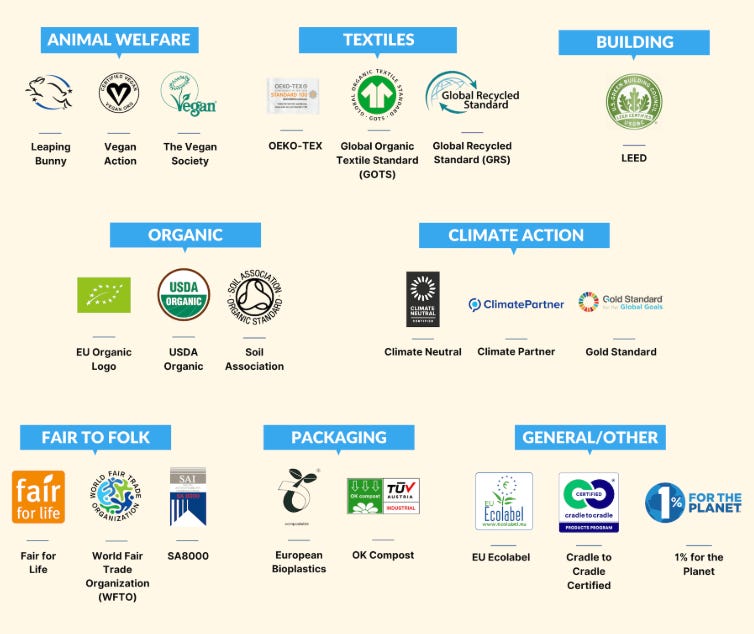
COST
Key cost components that are impacting the price you pay as a consumer:
Material - This typically accounts for 60-70% of a garment which is why cashmere is considered a premium luxe fabric. The cashmere I was sourcing was $100/kilo compared to cottons ($12-$20/kilo) and acrylics ($2-$6/kilo)
Garment weight -The heavier the fabric, the higher the cost. This is why a lot of times, a luxe yarn like cashmere will be knit in a really basic design because it can then be more affordable (or cost engineered through tension to make it lighter) vs why you can also get a really beautiful chunky, heavy stitch poly/nylon blend sweater at a great price because the yarn cost is low so they can add all the bells and whistles to the design.
Labor - China is hands down where you will get the highest quality production for sweaters at a large-to-mass size level. The factories are highly technical in their skill set and efficient in their processes. Other countries are catching up but may only be able to do more basic construction or at a much higher cost (which is why sweaters made out of countries like Peru, Italy, or the US are significantly more expensive).
This is why it’s hard to understand the price-value without touching, feeling, and wearing a sweater first so I recommend doing your research and not settling for the first one, or few, sweaters you look at! It’s a blend of the quality of yarn and how much is used along with the construction and design but under the price tag, it’s also the country it’s being produced out of, the sustainability efforts, and the margins being taken.
SHOPPING + SECONDHAND
Some high level shopping tips:
When it comes to shopping for any article of clothing, I make sure to read the fabric content and touch and feel the garment. Make sure to follow the tips mentioned above - touch, rub, light, stretch!
For sweaters, I tend to like that brands that are knitwear-first as they have really thoughtful and intentional focus to designing the yarns and garments vs brands that operate across every category. (Not always the case but a general observation I’ve found!)
I find client comments can be helpful for initial purchases but I take it with a grain of salt as you truly don’t know the quality of a sweater until you see how it performs over time and so much of it is dependent on proper care and storage.
It’s no secret that the overall quality of materials has gone down over the years. With the introduction of fast fashion, factories are expected to deliver faster and cheaper, and brands may cost engineer at the expense of quality to stay cost-competitive. Some may even reduce the overall quality while increasing the pricing to meet margin targets. 😬
Secondhand is one of the best places to shop for sweaters. You can usually find a high-quality sweater in great condition that will have more longevity than a brand new sweater in the market just for the fact that the materials used prior to fast fashion were built to last in someones wardrobe.
A few of the readers asked what brands I look for when it comes to secondhand sweaters. I’m sharing this with the caveat that quality varies greatly season to season, year to year. Brand strategies evolve, design direction and sourcing strategies change which can impact the quality of yarns used. Not to mention all the variations within production that can impact sweaters even produced in the same season (ie: a batch can be over washed, a dye can cause a dryer hand feel in certain colors or batches etc).
Some brands I love based on my own purchases or what I’ve sourced into for previous design + styling clients. Note this is for natural fibers only:
Opening Tier (under $200): Massimo Dutti, J. Crew, Uniqlo, Naadam, Quince
Mid-Tier ($200-$450): COS, Theory, Eileen Fisher, Micaela Greg, Loulou Studio, Babaà, Toast, Skall Studio, Soft Goat, White + Warren
High-Tier ($500+): Lauren Manoogian, Old Cèline, Lafayette 148, Lisa Yang, N. Peal, Arch4, Co., Nili Lotan, Toteme, Gabriela Hearst
**Pro Tip: Make sure to check out the Mens section too! I find Mens has incredible attention to detail vs Women’s as they are less dependent on churning out a bunch of new unique styles (focused on slight updates to core bodies through color, pattern, texture). I usually find slightly heavier sweaters, great essentials, and more interesting colors.
As I need to touch and feel sweaters, I only buy from places I can shop in-person or return if needed. My go-to spot is The RealReal but there’s also a ton of great vintage/secondhand shops on Etsy and social media who are great at providing as much detail as possible so you can make an informed purchase. A lot of brands are starting to resell preloved on their own sites, which I think is a great evolution towards circularity. Apiece Apart, Ralph Lauren Vintage (some incredible rare pieces that’s $$$), Eileen Fisher Renew to name a few (shout out to our reader Becky who highlighted this in our chat!)
I mainly look at sweaters in Very Good or Excellent condition, sometimes Good depending on the description. I find that anything below that wasn’t very well maintained and can be hard to get back the original integrity of the sweater.
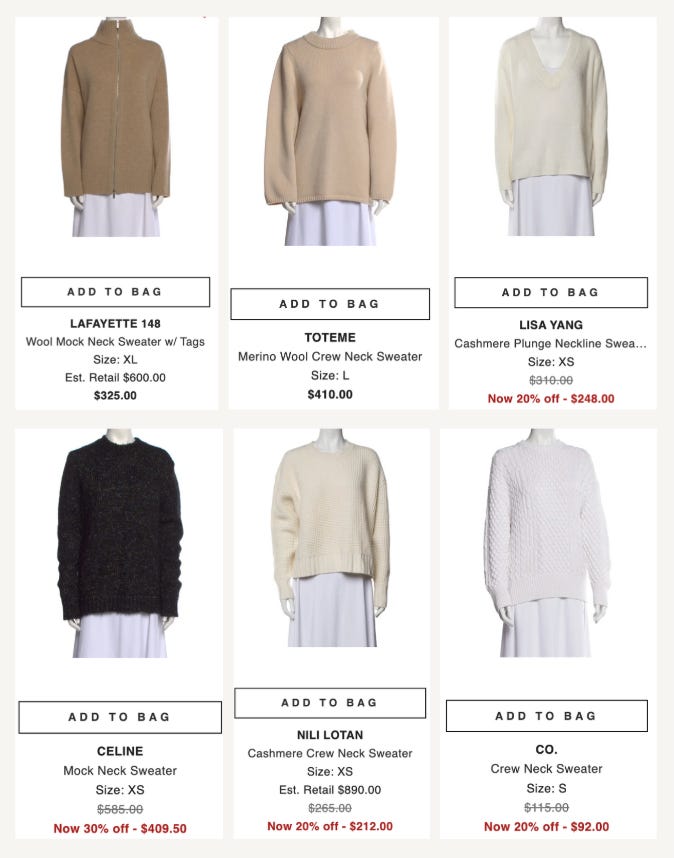
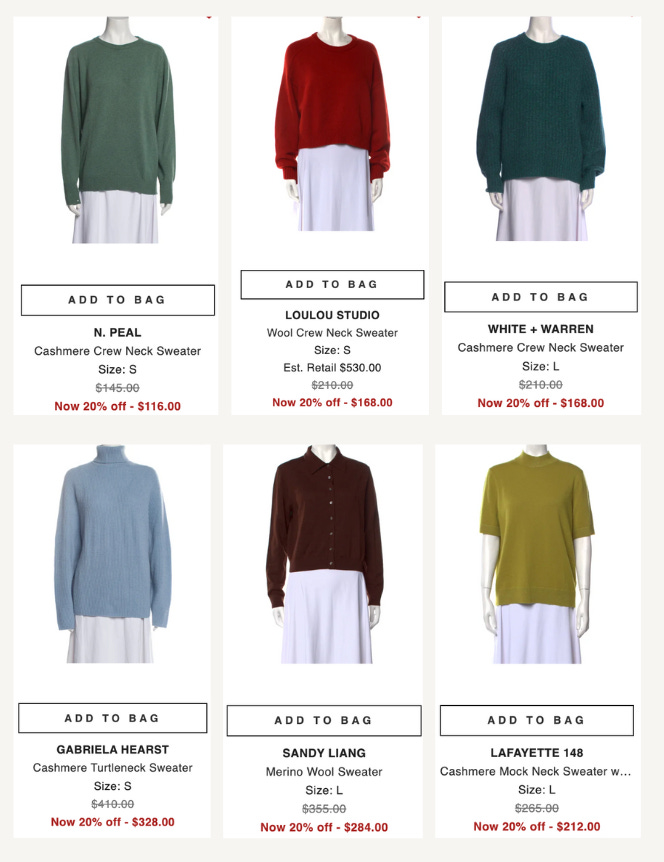
FIT
The main thing I think about when it comes to the fit of sweaters is the overall fit as it relates to the yarn. I’ve included some visual examples below in case this is something you’ve never looked at. A helpful exercise I do with clients1 - take some of your most worn and least worn sweaters and see if you prefer one vs the other and if you prefer certain armhole fits in relation to lightweight vs chunky sweaters.
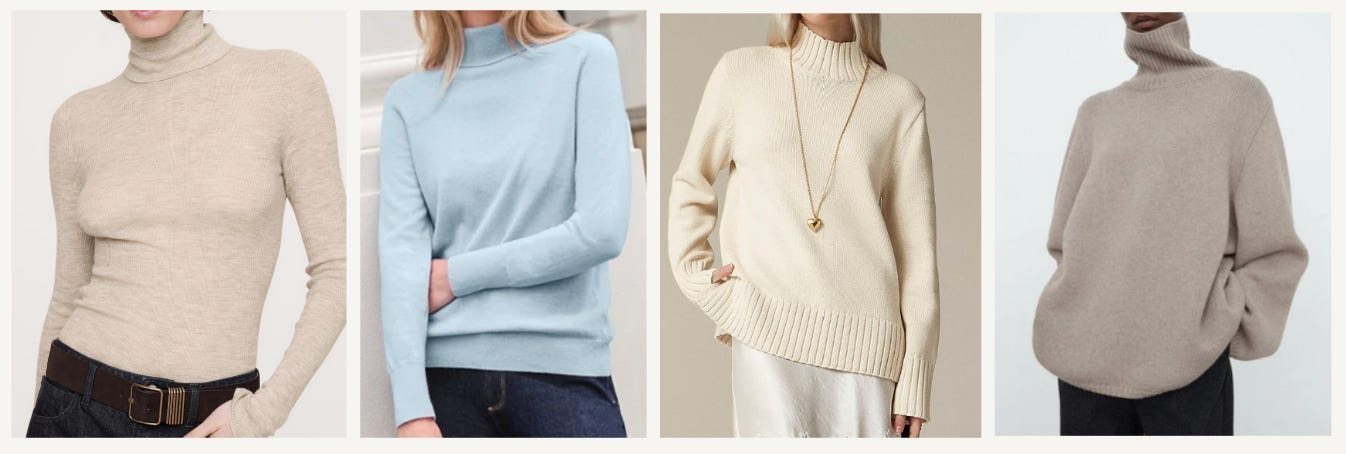
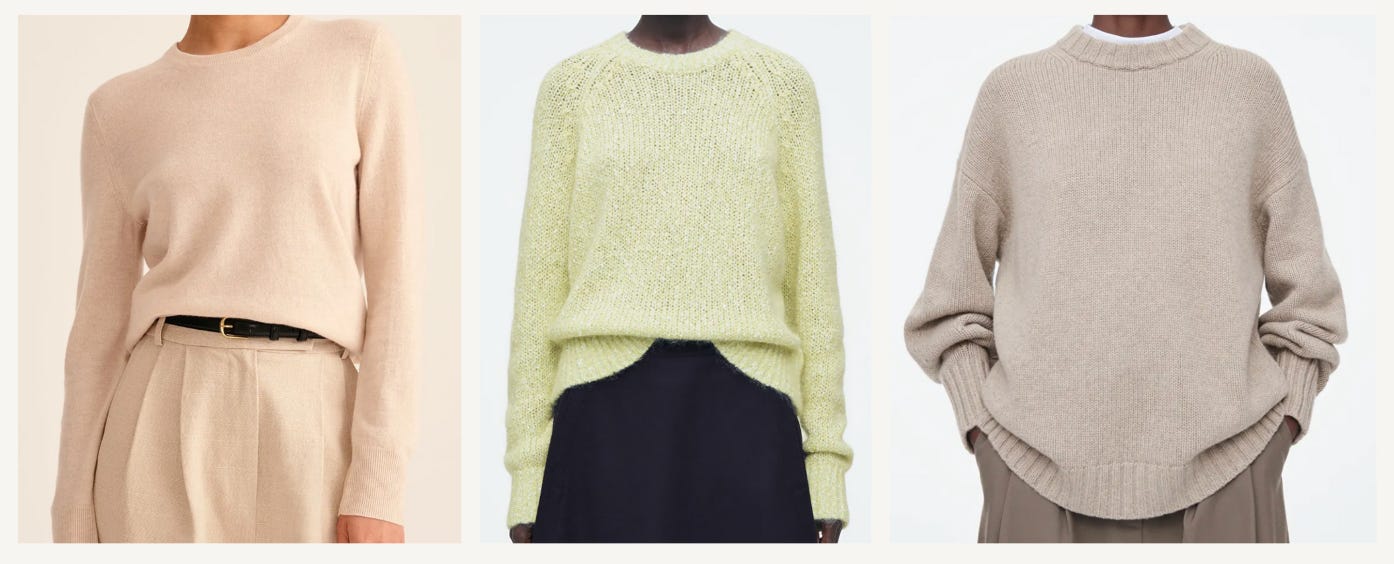
STYLING
Just a few simple winter/transitional styling tips for all your beautiful sweaters!
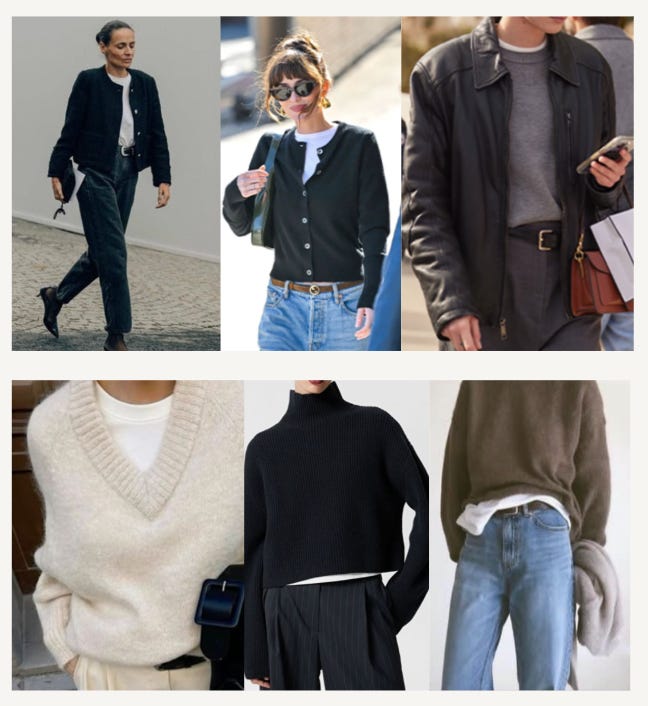
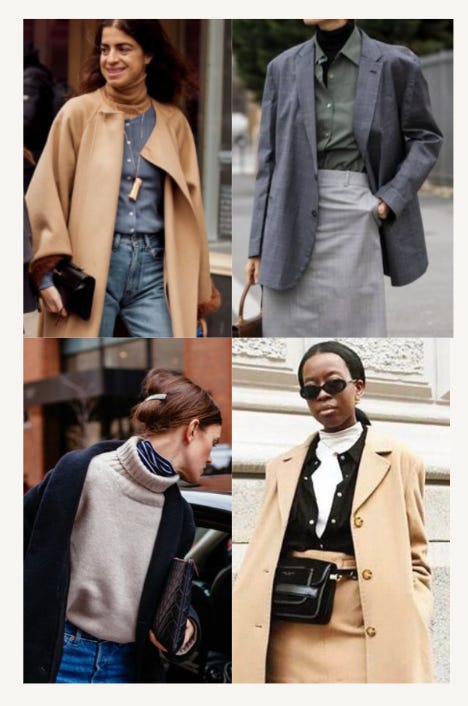
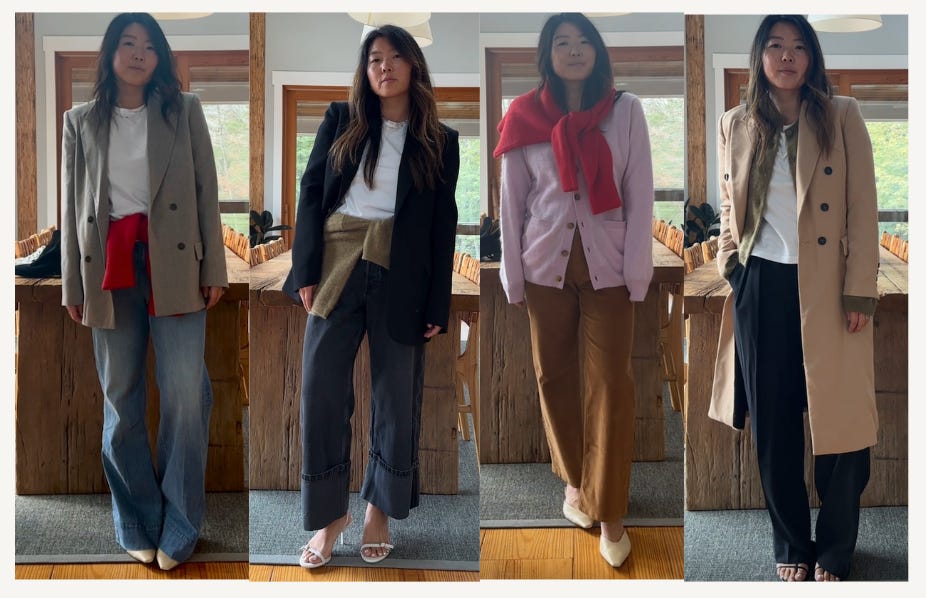
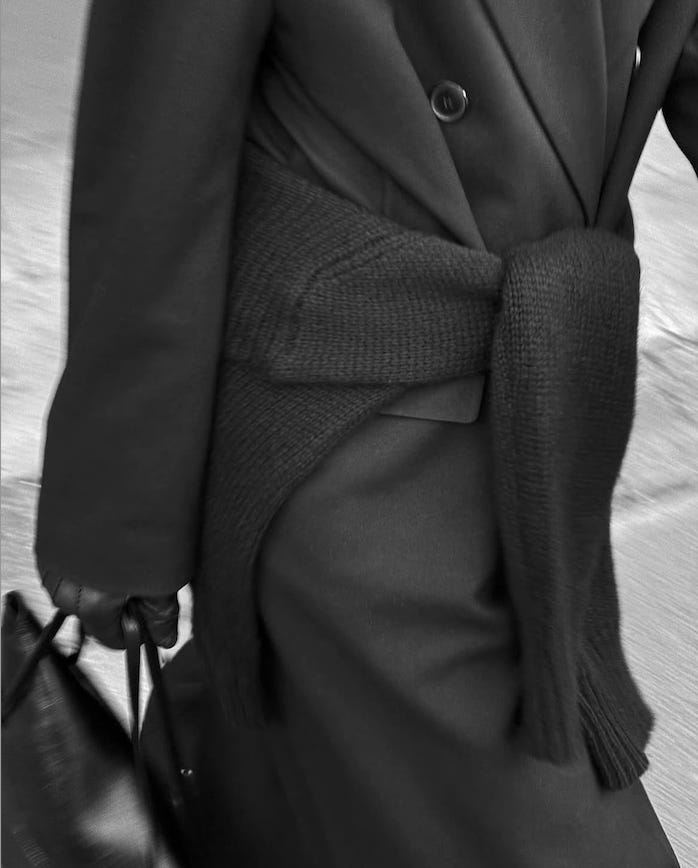
CARE
I think more important than trying to find the highest quality sweater is the care. Care will truly help extend the life of your sweaters. You can have a beautiful luxe $$$ sweater but if you don’t take care of it, signs of wear will occur very quickly and degrade the quality.
RULE #1 - DON’T OVERWASH
It’s a common myth that you should wash your sweaters after every few wears, or on a similar cycle with regular clothing but natural fibers were meant to withstand the elements so there’s a lot of inherent cleaning properties that trap and release odors.
I only wash my sweaters 1-2x, usually at the end of the season. If I happen to get a stain, or wear something a ton, I’ll give it a quick wash.
Avoid dry cleaning as it breaks down the fibers faster and causes your sweaters to have a dryer hand feel.
How I was my sweaters: I use Euclan but I’ve also heard good things about Soak - both are non-rinse shampoo which are really convenient!
There’s also a good amount of merino wool that’s easy care. I’ve had success machine washing lightweight cashmere and merino wool but I usually reserve this for times I’m short on time (or lazy). Key tips: use cold water (heat causes wool to shrink, felt, and pill), hand wash cycle, sweater specific detergent, low or no spin, follow the drying steps from the hand wash process from the video.
RULE #2 - STEAMING IS YOUR SWEATERS BFF
I steam in between washes to keep them looking and smelling fresh. This helps kill odor causing bacteria gently by lifting surface level dirt, allergens, and sweat from clothes and can provide a deeper clean on harder to wash fabrics like cashmere and wool.
How I steam my sweaters: I use a sweater spray (like this) and then steam to help release wrinkles and keep them fresh in between wears. This is my favorite at-home one and this is my travel one. My mom also recently got me this from Costco because she knows how much I love to steam and it’s pretty great! I like to use it for thicker wool coats or sweaters where the creases are harder to get out.
Rule #3 - DEPILL!
All sweaters will pill with wear, even the most luxe expensive ones. It’s not a sign of bad quality but lower qualities will pill much faster.
I use a sweater comb for quick touch ups but generally use an inexpensive electric depiller. Unlike washing, I try to depill frequently to avoid further friction around key wear zones (underarms, side seams, hem where it more frequently rubs up against a waistband).
I like to depill prior to washing my sweaters but you can also depill after!
Warning: the depiller sound is quite loud if you want to mute this video!
How I depill my sweaters: I use this basic depiller. This is also one I previously used for many years.
How I use a sweater comb - if a 90 degree angle doesn’t work, you can try a 45 degree angle.
STORAGE
Rule #1 - NEVER HANG YOUR SWEATERS.
Yarns are very delicate so by hanging them, it causes the garment to stretch out over time in both length and width, making it hard to recover it’s original shape. This is especially true for bulky or chunky knit sweaters. Hangers can also cause indentations and shape changes around the shoulders. Folding and stacking, or rolling, will be your friend!
Tips to keep your sweaters smelling fresh and free of moths: Toss a satchel of lavender, some cedar blocks, or I’ve also used wrapped bars of beautifully scented soap, or tissue paper sprayed with my perfume and wrapped in a satchel.
Rule #2 - DON’T STORE UNWASHED SWEATERS
If you switch out seasonal clothes in your closet to/from storage or bins, it’s tempting to just pack away your sweaters at the first sign of Spring and forget about them for 6 months.
Please wash your sweaters if you are storing them in a space that doesn’t have a ton of air circulation as it will be prone to moths, odd smells, and staining.
If you have time, try to wash and depill before storing sweaters so that when you are ready to wear next season, they are ready to go!
I hope this was a helpful topic - please do let me know in the comments, along with any additional questions, feedback or tips I may not be aware of and share with anyone who may benefit from these tips!
xx,
Angie
If you want to refine your style and learn the whys behind your style preferences so you can build a more intentional wardrobe full of pieces you love, a styling service could be for you! I’ll be updating my services and increasing pricing in the new year, so if you were interested in working together, book a free discovery call and let’s talk about your style challenges!




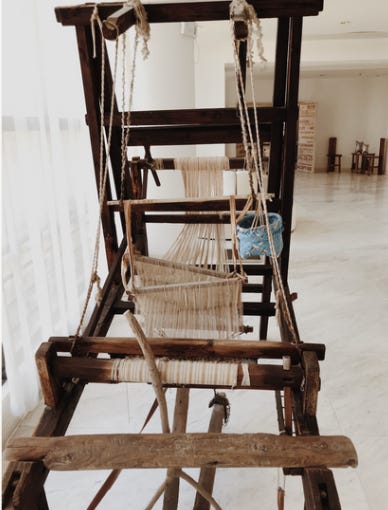
This was incredibly detailed and helpful. Thank you for doing this and sharing all of your knowledge with us!
Angie, this is an incredible wealth of knowledge you just shared with us! Thank you for this thoughtful post--I'm earmarking it for future reference. I find the whole production process fascinating, too! And it's so true, when we learn how much love goes into the making of a piece, it reminds us to care for it with love too.